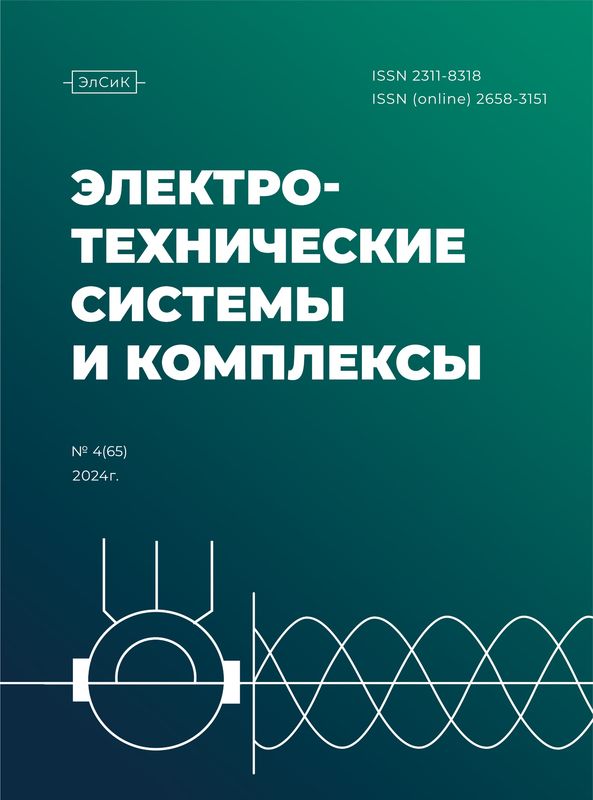Abstract
Emergency control of modern power systems places increased demands on analysis algorithms speed and ensuring acceptable parameters of post-emergency operating modes. The increase in the speed of transient processes due to a decrease in the power system total inertia and the development of new emergency process types make it necessary to develop and implement the principle of emergency control using the "After" method, which involves the synthesis of the changing parameters law in the electrical mode at the rate of the transient process. One class of mathematical methods that can ensure the speed and adaptability of emergency control in modern power systems are machine learning algorithms. The paper presents an adaptive technique for selecting control actions to ensure acceptable current loads of electrical network elements and voltage levels in post-emergency operating modes based on machine learning algorithms. The main research areas, emergency control problems are considered, their advantages and disadvantages are identified. The proposed methodology was tested on the IEEE14 mathematical model of the power system, using which a synthetic data sample was generated consisting of 13205 electrical modes. The task of selecting control actions was divided into two subtasks consisting of selecting the action volumes and their implementation places. To select the implementation volumes of control actions for both considered criteria of the power system post-emergency operation quality, the random forest algorithm was chosen. The classification of implementation places of control actions is performed using a graph neural network. The conclusions present the main results of the study and provide directions for future work.
Keywords
power system, control action, emergency control, machine learning, mathematical modeling
1. Suvorov A.A. Mechanisms of occurrence of subsynchronous oscillations in power systems with power inverter converters. Part 1. Elektrichestvo [Elektrichestvo], 2025, no. 1, pp. 17-31. (In Russian). doi:10.24160/0013-5380-2025-1-17-31
2. Kostoglodova S.L., Lotsman D.S., Maksimenko D.M., Neuymin V.G., Ostanin A.Yu. Integration of the stability margin monitoring system with technological tools of the electricity and capacity market. Izvestiya NTTs Edinoy energeticheskoy sistemy [Bulletin of the Scientific and Technical Center of the Unified Energy System], 2021, no. 1, pp. 89-95. (In Russian)
3. Senyuk M.D., Pazderin A.V., Berdin A.S., Klassen V.V. Methods for assessing low-frequency oscillations in the power system. Elektrichestvo [Elektrichestvo], 2024, no. 8, pp. 4-14. (In Russian). doi:10.24160/0013-5380-2024-8-4-14
4. Hatziargyriou N., Milanovic J., Rahmann C., Ajjarapu V., Canizares C., Erlich I. Definition and Classification of Power System Stability – Revisited & Extended IEEE Transactions on Power Systems. 2021, no. 36(4), pp. 3271-3281.doi: 10.1109/TPWRS.2020.3041774
5. Gerasimov A.S., Koshcheev L.A., Kritskiy V.A., Lisitsyn A.A. Automatic emergency control in power systems. Elektricheskie stantsii [Electrical stations], 2020, no. 1, pp. 41-49. (In Russian)
6. Aprosin K.I., Khokhrin A.A., Ivanov Yu.V. Evaluation of the dosage of control actions of automation to prevent instability based on synchronized vector measurements. Relayshchik [Protection engineer], 2021, no. 3 (41), pp. 26-31. (In Russian).
7. Senyuk M.D., Pazderin A.V., Klassen V.V. Improving the centralized system of emergency automation of the electric power system based on machine learning methods. Elektrotekhnicheskie sistemy i kompleksy [Electrotechnical systems and complexes]. 2024, no. 4 (65), pp. 14-24. (In Russian). doi: 10.18503/2311-8318-2024-4(65)-14-24
8. Luzhkovsky Yu.I. Coordination of the operation of local automation for preventing instability and automation for limiting equipment overload. Izvestiya vysshikh uchebnykh zavedeniy. Elektromehanika. [Bulletin of Higher Educational Institutions. Electromechanics], 2014, no. 3, pp. 103-105. (In Rusian)
9. Satsuk E.I., Luzhkovsky Yu. I., Zasypkin A.S., Teterin A.D. Algorithms for adaptive automation for limiting overload of an overhead power line with wire temperature monitoring. Energetic. [Energetik], 2015, no. 12, pp. 8-12. (In Russian)
10. Duan J., Liu R., Hu X., Hao J., Luo J. Decision Tree Detection Method for Overload Fault of Distribution Network Lines Under Load Disturbance. 3rd International Conference on Energy, Power and Electrical Engineering (EPEE). IEEE, 2023. Pp. 1078-1081. doi: 10.1109/EPEE59859.2023. 10352010
11. Gao T., Zhang T., Si R., Xu P., Lv C., Zhang J. A Self-Evolving Agent System for Power System Online Corrective Control. IEEE Journal of Radio Frequency Identification. 2022, vol. 6, pp. 876-880. doi: 10.1109/JRFID.2022. 3205727
12. Cui H., Ye Y., Hu J., Tang Y., Lin Z., Strbac G. Online Preventive Control for Transmission Overload Relief Using Safe Reinforcement Learning With Enhanced Spatial-Temporal Awareness. IEEE Transactions on Power Systems. 2024, no. 39(1), pp. 517-532. doi: 10.1109/TPWRS.2023.3257259
13. Labed, I., Labed, D. Extreme learning machine-based alle-viation for overloaded power system. IET Gener. Transm. Distrib., 2019, no. 13(22), pp. 5058-5070. doi: 10.1049/iet-gtd.2019.0531
14. Sengupta A. Prevention of Load Encroachment Using Model Predictive Control. IEEE Transactions on Power Delivery. 2021, no. 6(36), pp. 3657-3670. doi: 10.1109/TPWRD.2020. 3046359
15. Dautov A.A., Popov M.G., Goryachevskiy K.S., Sinianskiy I.V., Odruzova V.A. Improvement and Testing of Upgraded Power Lines Unloading Automatics by Power Overload with Correction of Tripping Characteristics. IEEE Conference of Russian Young Researchers in Electrical and Electronic Engineering (ElConRus). IEEE, 2021. Pp. 833-838. doi: 10.1109/ElConRus51938.2021.9396175
16. Glavic M., Cutsem T.V. Adaptive wide-area closed-loop undervoltage load shedding using synchronized measures. IEEE PES General Meeting.IEEE, 2010. Pp. 1-8. doi: 10.1109/PES.2010.5589279
17. Kisengeu S.M., Nyakoe G.N., Muriithi C.M. Under Volt-age Load Shedding using Hybrid Metaheuristic Algorithms for Voltage Stability Enhancement: A Review. IEEE PES/IAS PowerAfrica. IEEE, 2020. Pp. 1-5. doi: 10.1109/ PowerAfrica49420.2020.9219810
18. Huang Q., Huang R., Hao W., Tan J., Fan R., Huang Z. Adaptive Power System Emergency Control Using Deep Reinforcement Learning. // IEEE Transactions on Smart Grid. 2020, no. 2(11), pp. 1171-1182. doi: 10.1109/TSG.2019. 2933191
19. Yasin Z.M., Rahman T.K.A., Zakaria Z. Quantum-Inspired Evolutionary Programming-Artificial Neural Network-work for prediction of undervoltage load shedding. 2013 IEEE 8th Conference on Industrial Electronics and Applications (ICIEA). IEEE, 2013. Pp. 583-588. doi: 10.1109/ICIEA.2013. 6566436
20. Pei Y., Yang J., Wang J., Xu P., Zhou T., Wu F. An emergency control strategy for undervoltage load shedding of power system: A graph deep reinforcement learning method. IET Gener. Transm. Distrib. 2023, no. 17, pp. 2130-2141. doi: 10.1049/gtd2.12795
21. Zhu L., Luo Y. Deep Feedback Learning Based Pre-dictive Control for Power System Undervoltage Load Shedding. IEEE Transactions on Power Systems. 2021, no. 4(36), pp. 3349-3361. doi: 10.1109/TPWRS.2020.3048681
22. Isaev E.V., Kats P.Ya., Lisitsyn A.A., Nikolaev A.V. Ten Algorithm for calculating control actions based on the condition of ensuring the standard voltage reserve in the circuit nodes and preventing current overload of network elements in the post-emergency mode of the power system. Izvestiya NTTs Edinoy energeticheskoy sistemy [Bulletin of the Scientific and Technical Center of the Unified Energy System], 2013, no. 1, pp. 58-68. (In Russian)
23. Solheim O.R., Hoverstad B.A., Korpas M. Using Graph Neural Networks in Reinforcement Learning With Application to Monte Carlo Simulations in Power System Reliability Analysis. IEEE Access. 2024, vol. 12, pp. 160175-160189. doi: 10.1109/ACCESS.2024.3486354
Senyuk M.D., Pazderin A.V., Klassen V.V. Ensuring Allowable Current Loads and Voltage Levels in Centralized Emergency Control Systems Based on Machine Learning Algorithms. Elektrotekhnicheskie sistemy i kompleksy [Electrotechnical Systems and Complexes], 2025, no. 2(67), pp. 15-24. (In Russian). https://doi.org/10.18503/2311-8318-2025-2(67)-15-24










